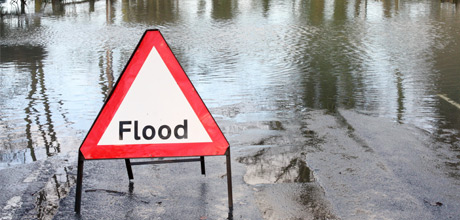Flooding and Storms
We’re here to get you through the storms and floods
When a storm hits, the effects can be devastating. So whether you want information on storms heading your way; guidance on how to minimise the impact of storm damage; or you need to make a claim, we’re here to help.

- Sign up to Floodline for free flood warnings by phone or text
- Keep an eye on the Government’s flood warning site
- Find out the likelihood of flooding in your area on the UK Government website
- Check out the Met Office weather warnings in your area
- Keep an eye on river levels in your area with www.gaugemap.co.uk
Flood plan checklist
Farm flood planning
A farm flood plan should look at the following areas:
- Identify fields at higher ground where livestock can be moved to safety and gain permission to use these in advance of flooding if they are not your own
- Identify stock, machinery and tools that can easily be moved off the farm to prevent loss or damage
- Identify any chemicals or fuels on the farm that could contaminate floodwater and think about how they could be moved to safety during a flood
- Consider how you will inform staff about an impending flood and how staff may be able to help you prepare
- Draw up a contingency plan with suppliers to ensure business continuity to reduce loss of earnings
- Consider purchasing a stockpile of useful materials that can be used during a flood such as sandbags to prevent water entering barns or sheds, plywood to board up windows and pallets to raise stock and equipment above floodwater level.
Home flood planning
In most cases, the farm will also be a home. In the home, there should be a flood plan and a flood kit, so that everyone knows how to respond if a flood occurs. You should also:
- Familiarise yourself with how to shut off gas, electricity and water supplies
- Keep a list of useful contact numbers handy
- Consider flood protection products that could help to reduce the impact of flooding on
- your property and ensure your insurance provides adequate cover for flood damage.
There are lots of products and techniques you can use to keep floodwater out of the house and to minimise its impact if it does get in, such as water-resistant skirting and specially made flood doors. You can read this government guidance about this.
Reducing the likelihood of flooding on farm
Managing a flood is one thing, but reducing the likelihood of it happening is another. Here are some tips for farmers to consider, to reduce the risk of flooding on your farm:
- Consider creating run-off ponds, or sediment traps on the farm to reduce the likelihood of flooding
- Avoid directing run off towards roads and watercourses
- Discharge roof water into swales and/or soakaways around the farm, to slow water down and recharge groundwater
- Loosen soil to leave a rough surface after harvesting to allow more water to soak in rather than run off land
- Remove stock when soils are wet in high-risk fields
- Use low-ground-pressure tyres to reduce soil compaction.
(source: Farmers Weekly: http://www.fwi.co.uk/farm-life/advice-to-help-product-your-farm-during-flooding.htm)
Making a claim can be stressful but our 24/7 UK-based claims team aims to take the hassle out of the experience for you. We want to get you back to normal as soon as possible.
Our claims promise to you
- Dedicated claims handler
- 24/7 claims line
- Quick deployment of loss adjusters
- Interim payments where required
- Alternative accommodation if appropriate
- Supported by industry professionals
- Experienced large loss team
- Repairs using our approved network guaranteed
If you need to make a claim visit: ruralinsurance.co.uk/claims/make-a-claim to download our claims forms or call 01937 838 050 (office hours) / 0208 150 5265 (any other time)


